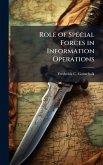This thesis focuses on the impact of character in Special Forces (SF), or its lack thereof, through the historical analysis of various warrior sects and key historical figures. This research then contrasts current perceptions of character within SF soldiers with the historical examples of character. The objective of the research is to determine whether there is an issue with character within SF, and whether this aspect of the human warrior system should be trained in the Special Forces Qualification Course. Traditionally, the Army has focused its efforts on identifying and selecting individuals for units based on physical, mental, and character attributes that are demonstrated over a designated period. However, this approach misses the mark because it only predicts potential character and performance within an individual. SF soldiers today are being placed into situations that are morally ambiguous and their decisions will have both operational and strategic impact. The problem is that often, they neither hold, nor have they necessarily been adequately trained in the Army's and SF's organizational values. These values are the bedrock upon which a soldier's moral foundation is built, and it is this foundation that enables the Army's soldiers and leaders to judge and discern. This work has been selected by scholars as being culturally important, and is part of the knowledge base of civilization as we know it. This work was reproduced from the original artifact, and remains as true to the original work as possible. Therefore, you will see the original copyright references, library stamps (as most of these works have been housed in our most important libraries around the world), and other notations in the work. This work is in the public domain in the United States of America, and possibly other nations. Within the United States, you may freely copy and distribute this work, as no entity (individual or corporate) has a copyright on the body of the work. As a reproduction of a historical artifact, this work may contain missing or blurred pages, poor pictures, errant marks, etc. Scholars believe, and we concur, that this work is important enough to be preserved, reproduced, and made generally available to the public. We appreciate your support of the preservation process, and thank you for being an important part of keeping this knowledge alive and relevant.
Bitte wählen Sie Ihr Anliegen aus.
Rechnungen
Retourenschein anfordern
Bestellstatus
Storno








